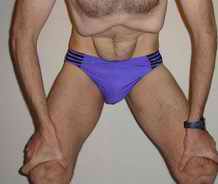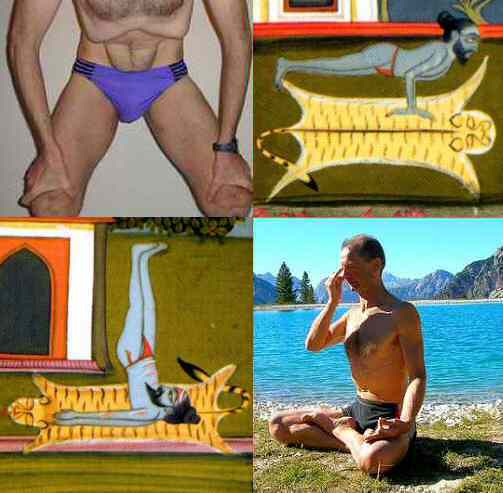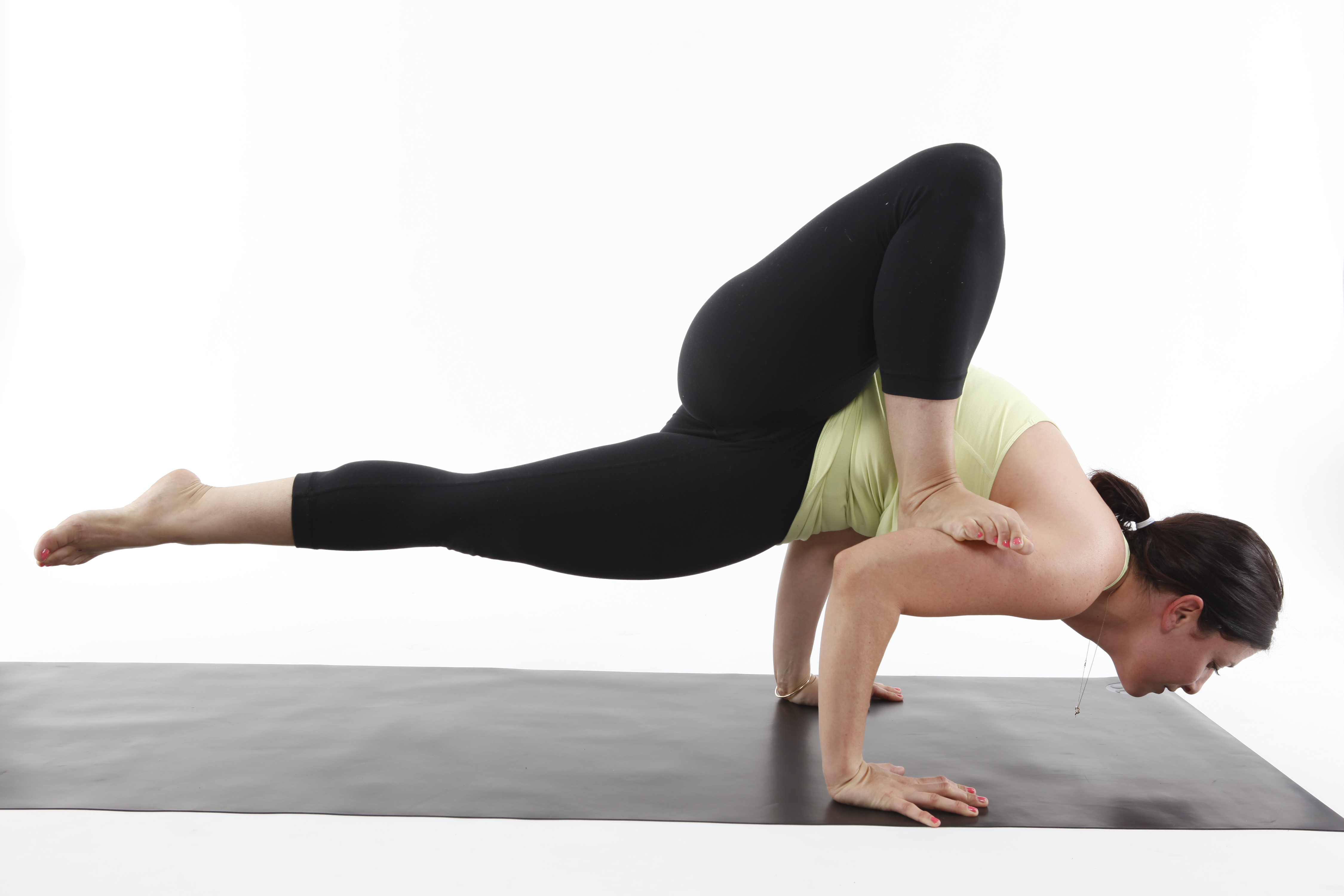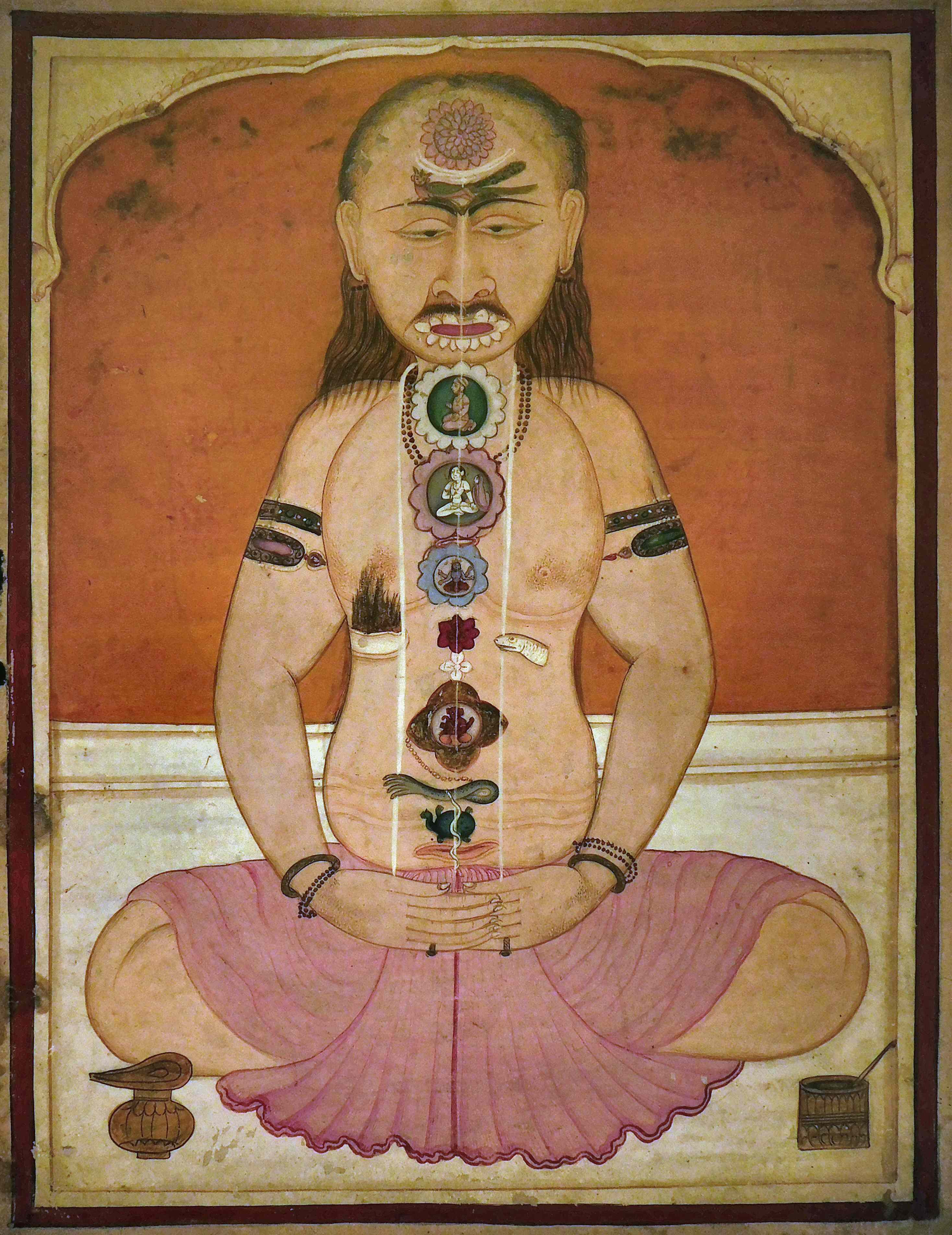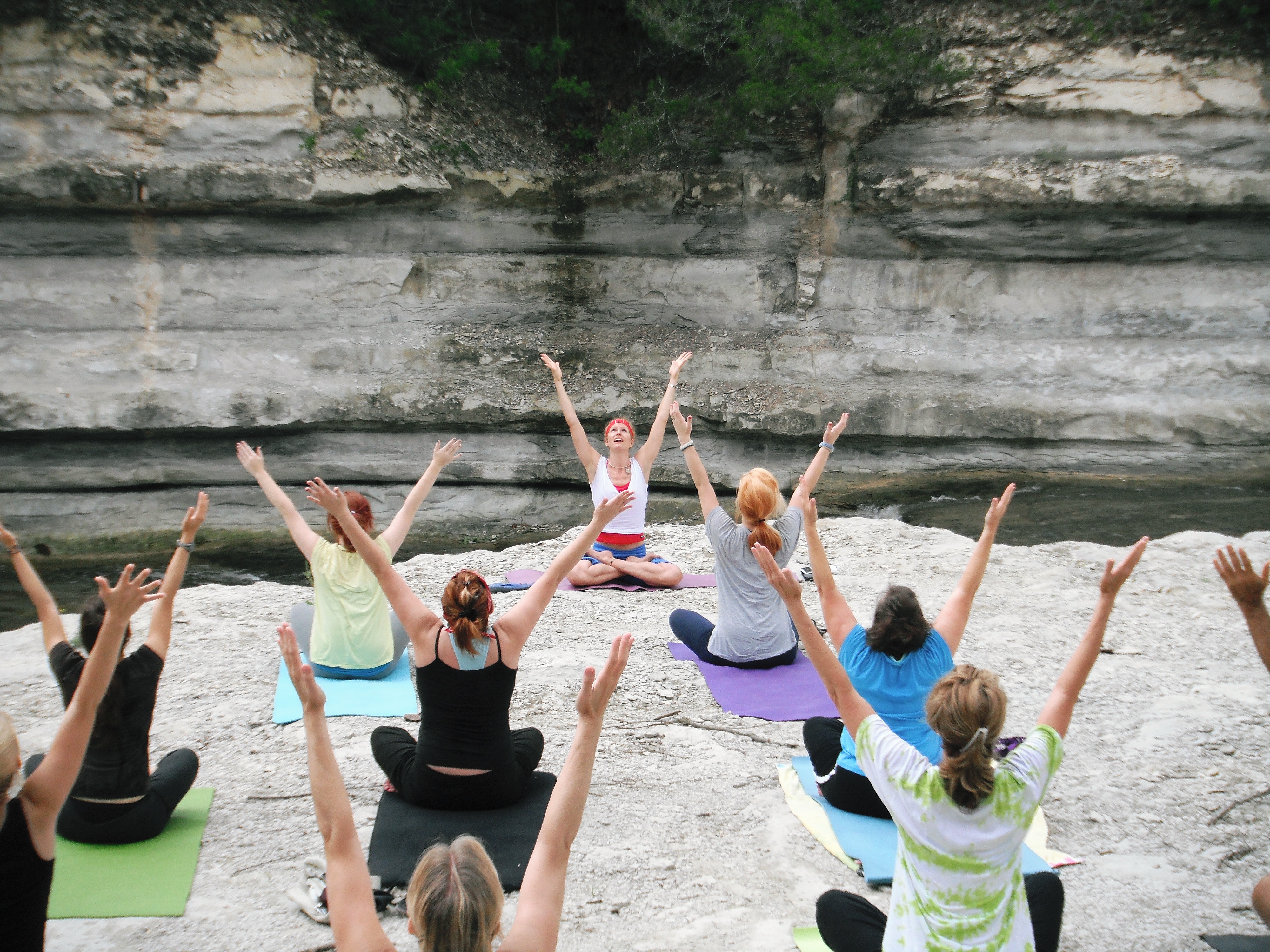|
Nauli
__notoc__ Nauli is one of the '' kriyas'' or ''shatkarmas'', preliminary purifications, used in yoga. The exercise is claimed to serve the cleaning of the abdominal region (digestive organs, small intestine) and is based on a massage of the internal belly organs by a circular movement of the abdominal muscles. It is performed standing with the feet apart and the knees bent. The 15th century ''Hatha Yoga Pradipika'' claims that Nauli (magically) removes all diseases. ''Nauli'' is an exercise of classical hatha yoga; it is not often taught in yoga as exercise. There are four steps, which are learned one after another: # the abdominal lock, uddiyana bandha A bandha () is a kriyā in Hatha Yoga, being a kind of internal mudra described as a "body lock," to lock the vital energy into the body. ''Bandha'' literally means bond, fetter, or "catching hold of".Iyengar, 1976: pp.435–437Iyengar, 1976: p.52 ...: the lungs are emptied, and the abdomen is pulled inwards and upwards under ... [...More Info...] [...Related Items...] OR: [Wikipedia] [Google] [Baidu] |
Hatha Yoga
Hatha yoga (; Sanskrit हठयोग, International Alphabet of Sanskrit Transliteration, IAST: ''haṭhayoga'') is a branch of yoga that uses physical techniques to try to preserve and channel vital force or energy. The Sanskrit word हठ ''haṭha'' literally means "force", alluding to a system of physical techniques. Some hatha yoga style techniques can be traced back at least to the 1st-century CE, in texts such as the Hindu Itihasa, Sanskrit epics and Buddhism's Pali canon. The oldest dated text so far found to describe hatha yoga, the 11th-century ''Amritasiddhi, Amṛtasiddhi'', comes from a Tantra, tantric Buddhist milieu. The oldest texts to use the terminology of ''hatha'' are also Vajrayana Buddhist. Hindu hatha yoga texts appear from the 11th century onward. Some of the early hatha yoga texts (11th-13th c.) describe methods to raise and conserve bindu (vital force, that is, semen, and in women ''rajas –'' menstrual fluid). This was seen as the physical esse ... [...More Info...] [...Related Items...] OR: [Wikipedia] [Google] [Baidu] |
Uddiyana Bandha
A bandha () is a kriyā in Hatha Yoga, being a kind of internal mudra described as a "body lock," to lock the vital energy into the body. ''Bandha'' literally means bond, fetter, or "catching hold of".Iyengar, 1976: pp.435–437Iyengar, 1976: p.525 ''Maha Bandha'' Mahā Bandha ("the great lock") combines all the other three bandhas, namely: * Mula Bandha, contraction of the perineum * Uddiyana bandha, contraction of the abdomen into the rib cage * Jalandhara Bandha, tucking the chin close to the chest In Ashtanga Yoga, these three Bandhas are considered to be one of the three key principles of yoga practice. ''Mula bandha'' ''Mūla bandha'' is a primary ''bandha'' in traditional yoga. The earliest textual mention of ''mūla bandha'' is in the 12th century Shaiva Natha text '' Gorakṣaśataka'' which defines it as a yogic technique to achieve mastery of breath and to awaken the goddess Kuṇḍalinī. Etymology Mula Bandha (Sanskrit: मूल बंध) is from ''Mūla'', ... [...More Info...] [...Related Items...] OR: [Wikipedia] [Google] [Baidu] |
Shatkarmas
The shatkarmas (Sanskrit: षटकर्म ''ṣaṭkarma'', literally ''six actions''), also known as shatkriyas,Shatkarmas - Cleansing Techniques in Yoga Magazine, a publication of are a set of purifications of the body, to prepare for the main work of yoga towards (liberation). These practices, outlined by |
Shatkarma
The shatkarmas (Sanskrit: षटकर्म ''ṣaṭkarma'', literally ''six actions''), also known as shatkriyas,Shatkarmas - Cleansing Techniques in Yoga Magazine, a publication of are a set of purifications of the body, to prepare for the main work of yoga towards (liberation). These practices, outlined by |
Yoga
Yoga (UK: , US: ; 'yoga' ; ) is a group of physical, mental, and spiritual practices or disciplines that originated with its own philosophy in ancient India, aimed at controlling body and mind to attain various salvation goals, as practiced in the Hindu, Jain, and Buddhist Buddhism, also known as Buddhadharma and Dharmavinaya, is an Indian religion and List of philosophies, philosophical tradition based on Pre-sectarian Buddhism, teachings attributed to the Buddha, a wandering teacher who lived in the 6th or ... traditions. Yoga may have pre-Vedic period, Vedic origins, but is first attested in the early first millennium BCE. It developed as various traditions in the eastern Ganges basin drew from a common body of practices, including Vedas, Vedic elements. Yoga-like practices are mentioned in the ''Rigveda'' and a number of early Upanishads, but systematic yoga concepts emerge during the fifth and sixth centuries BCE in ancient India's sannyasa, ascetic and ... [...More Info...] [...Related Items...] OR: [Wikipedia] [Google] [Baidu] |
Small Intestine
The small intestine or small bowel is an organ (anatomy), organ in the human gastrointestinal tract, gastrointestinal tract where most of the #Absorption, absorption of nutrients from food takes place. It lies between the stomach and large intestine, and receives bile and pancreatic juice through the pancreatic duct to aid in digestion. The small intestine is about long and folds many times to fit in the abdomen. Although it is longer than the large intestine, it is called the small intestine because it is narrower in diameter. The small intestine has three distinct regions – the duodenum, jejunum, and ileum. The duodenum, the shortest, is where preparation for absorption through small finger-like protrusions called intestinal villus, intestinal villi begins. The jejunum is specialized for the absorption through its lining by enterocytes: small nutrient particles which have been previously digested by enzymes in the duodenum. The main function of the ileum is to absorb vitami ... [...More Info...] [...Related Items...] OR: [Wikipedia] [Google] [Baidu] |
Massage
Massage is the rubbing or kneading of the body's soft tissues. Massage techniques are commonly applied with hands, fingers, elbows, knees, forearms, feet, or a device. The purpose of massage is generally for the treatment of body stress or pain. In English-speaking European countries, traditionally a person professionally trained to give massages is known by the gendered French loanwords ''masseur'' (male) or ''masseuse'' (female). In the United States, these individuals are often referred to as "massage therapists". In some provinces of Canada, they are called "registered massage therapists." In professional settings, clients are treated while lying on a massage table, sitting in a massage chair, or lying on a mat on the floor. There are many different modalities in the massage industry, including (but not limited to): deep tissue, manual lymphatic drainage, Medical massage, medical, sports, Structural Integration, structural integration, #Swedish massage, Swedish, Thai massa ... [...More Info...] [...Related Items...] OR: [Wikipedia] [Google] [Baidu] |
Yoga Journal
''Yoga Journal'' is a website and digital journal, formerly a print magazine, on yoga as exercise founded in California in 1975 with the goal of combining the essence of traditional yoga with scientific understanding. It has produced live events and materials such as DVDs on yoga and related subjects. The magazine grew from the California Yoga Teachers Association's newsletter, which was called ''The Word''. ''Yoga Journal'' has repeatedly won Western Publications Association's Maggie Awards for "Best Health and Fitness Magazine". It has however been criticized for representing yoga as being intended for affluent white women; in 2019 it attempted to remedy this by choosing a wider variety of yoga models. The magazine was acquired by Outside in 2020. Beginnings ''Yoga Journal'' was started in May 1975 by the California Yoga Teachers Association (CYTA), with Rama Jyoti Vernon as President, William Staniger as the founding editor, and Judith Lasater on the board and serving as ... [...More Info...] [...Related Items...] OR: [Wikipedia] [Google] [Baidu] |
Hatha Yoga Pradipika
The ''Haṭha Yoga Pradīpikā'' ( or Light on Hatha Yoga) is a classic fifteenth-century Sanskrit manual on haṭha yoga, written by Svātmārāma, who connects the teaching's lineage to Matsyendranath of the Nathas. It is among the most influential surviving texts on haṭha yoga, being one of the three classic texts alongside the ''Gheranda Samhita'' and the ''Shiva Samhita''. More recently, eight works of early hatha yoga that may have contributed to the ''Hatha Yoga Pradipika'' have been identified. Title and composition Different manuscripts offer different titles for the text, including ''Haṭhayogapradīpikā'', ''Haṭhapradīpikā'', ''Haṭhapradī'', and ''Hath-Pradipika''. It was composed by Svātmārāma in the 15th century as a compilation of the earlier haṭha yoga texts. Svātmārāma incorporates older Sanskrit concepts into his synthesis. He introduces his system as a preparatory stage for physical purification before higher meditation or Raja Yoga. S ... [...More Info...] [...Related Items...] OR: [Wikipedia] [Google] [Baidu] |
Yoga As Exercise
Yoga as exercise is a physical activity consisting mainly of asana, postures, often connected by vinyasa, flowing sequences, sometimes accompanied by pranayama, breathing exercises, and frequently ending with savasana, relaxation lying down or meditation. Yoga in this form has become familiar across the world, especially Yoga in the United States, in the US and Europe. It is derived from medieval Haṭha yoga, which made use of similar postures, but it is generally simply called "yoga". Academic research has given yoga as exercise a variety of names, including modern postural yoga and transnational anglophone yoga. Postures were not central in any of the older traditions of yoga; posture practice was revived in the 1920s by yoga gurus including Yogendra and Kuvalayananda, who emphasised its health benefits. The flowing sequences of Surya Namaskar (Salute to the Sun) were pioneered by the Rajah of Aundh State, Aundh, Bhawanrao Shrinivasrao Pant Pratinidhi, in the 1920s. It and ma ... [...More Info...] [...Related Items...] OR: [Wikipedia] [Google] [Baidu] |
